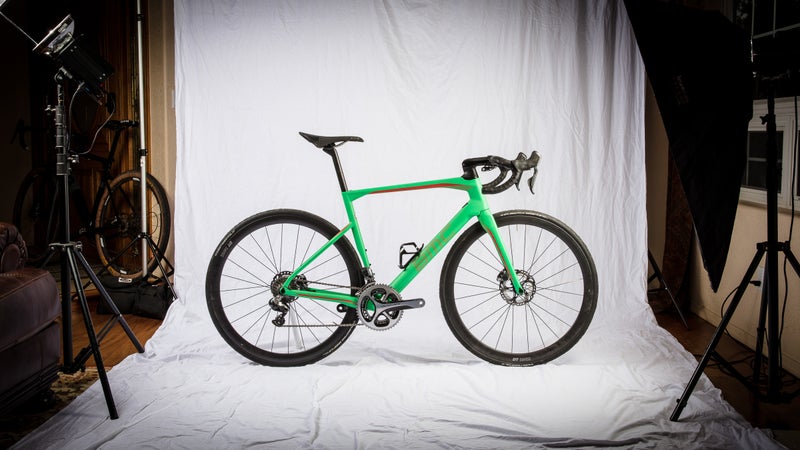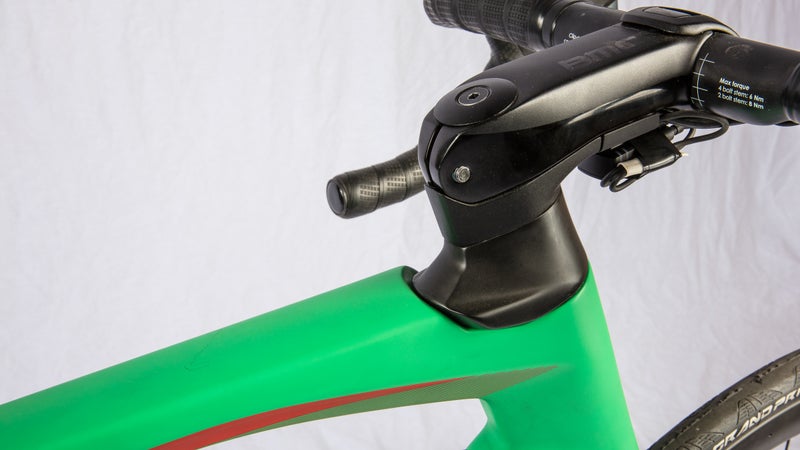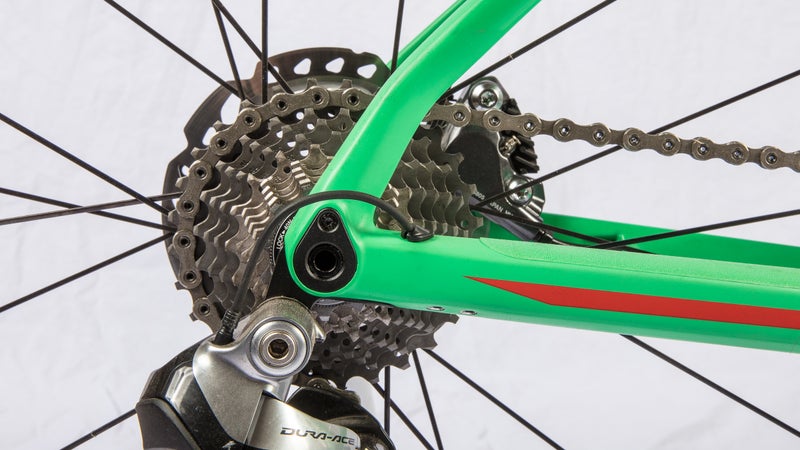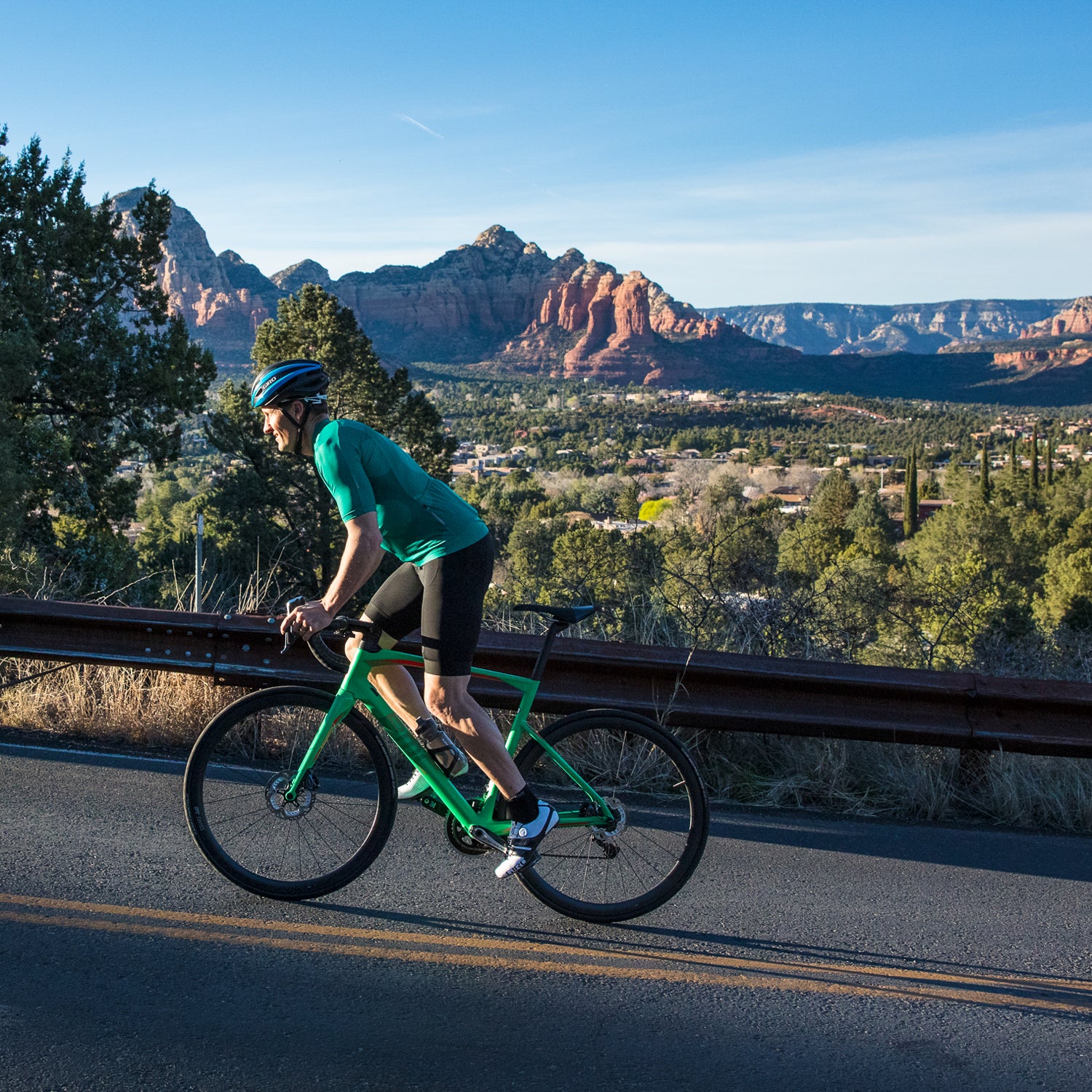The Good: The frame finds the right balance between race fast and endurance comfy. It’s nice to see companies finally building new high-end, speed-oriented bikes with disc brakes as the only option. With the full cable integration and superclean front end, this bike contends for sexiest of the year.
The Bad: Building a comfortable bike that has room for fatter tires, and then spec’ing 25mm rubber is one of the silliest decisions ever. We like the speed (and look) of the deep-section DT wheels, but something a little less stiff and heavy would have better complemented the ride. Also: $11,000? Are you serious?
The Verdict: For those who don’t need a flat-out race bike but aren’t interested in a gawky, tall endurance machine (much less a fat-tire gravel rig), the is the optimal middle ground. It’s the consummate modern-day road machine (ahem!); it’s whippy fast yet can handle a little of everything, even some dirt. The only problem: the stratospheric pricing ensures that this everyman’s bike won’t be available to just anyone.

Much has been made in recent years about the trend of adventure road bikes, which pair near mountain bike–width tires with stiff, drop-bar frames. We love these mashups, including our 2016 Gear of the Year–winning Open UP, for the breadth of terrain they can cover and the sheer versatility of taking one bike on everything from group rides with a peloton to singletrack. But the truth is that most roadies still spend most of their time on asphalt, where really fat rubber and large mud clearances are overkill. The Roadmachine offers features for the 90 percent.
Frame

BMC has done an excellent job of putting stiffer carbon in some places and softer carbon in others to allow for frame comfort where you want it and stiffness where you need it. The bottom bracket and chainstays on the Roadmachine are as rigid as any race bike, so you get that devastating acceleration and power transfer when you sprint and climb. The seatpost and fork, on the other hand, have vertical flex that absorbs the shock, and the lowered seatstay junction adds to the comfort.
The Roadmachine also finds great compromise between endurance and race positions. The head angle isn’t as steep as a typical race bike, and the bottom bracket is lower, both of which account for the bike’s rooted, stable feeling. But BMC has engineered two headset cones that raise and lower the stack height by two centimeters, so racers can still get an aggressive fit. We rode with the taller of the cones, creating a moderate position that wasn’t flagpole tall like some full endurance machines.
The other thing you immediately notice about the Roadmachine 01 is the gorgeous front-end integration: custom bars, stem, and spacers allow all the cables to run inside the tubes. Not only is it pretty, but it surely makes for excellent aerodynamics. One downside, of course, is the initial setup can be a bear, and changing the stack height may mean rebleeding those disc brakes. Our mechanics also discovered that with those cables inside the stem, it’s easy to crimp and short a Di2 wire if you spin the bars too far.
Everything else about the Roadmachine is exactly as it should be: 12mm thru-axles front and rear; flat-mount disc brake mounts, including a custom inset design on the front; fully internal cable routing; built-in chain catcher; custom plugs for unused ports; and a clean, clampless camming seatpost fastener. It’s Swiss detailing exemplified.
Components

We rode the absolute highest-end build of the Roadmachine 01. The Dura Ace Di2 drivetrain and top-level Shimano hydraulic disc brakes impressed, as they should. The compact crank combined with a wide cassette (11-28) made for easy climbing, thanks to all those little gears. However, we had one aggravation with the setup: the combination of the long cage on the rear derailleur and small front ring led to noisy chain slap on rough pavement and dirt.
The Roadmachine’s biggest, almost unforgivable misstep is the 25mm Continental GP4000 tires. This is great rubber for a race bike and would have been appropriate on the . But with all the tire clearance the engineers went to great lengths to create, this bike deserves at least 28s. Yes, it’s an easy fix. But for $11,000 out the door, every single component and choice should be spot-on.
Testers’ opinions varied on the DT Swiss RC38 carbon wheels. Some liked the fast feel of the tall rims and said they were a solid complement to the Roadmachine’s aero leanings. Others felt they added a stiffness to the ride that was at odds with the frame’s road-damping qualities. Those same detractors also pointed out that the wheels added unnecessary weight that pushed the bike to 16.3 pounds (size 54). The wheels are, of course, excellent and quick, and BMC could have preempted most of the quibbles with thicker tires, which would have added grams but softened the ride.
The Ride
On an $11,000 bike, you pretty much expect perfection—and happily, you basically get it. The Roadmachine is a stridently confident ride, pouncing forward when you step on the gas, motoring through rollers faster than you think it should, and sticking to the road as if on rails when descending. That low bottom bracket translates into a rooted, solid feel, especially on technical, sinuous downhills. I took it up our local ski hill climb, and on the sweeping, swirling return, I found myself smiling corner after corner because of how hard I could lay it over without feeling nervous.
I swapped to shallower rims with 30mm tires, and the confidence only grew. That also made the ride significantly softer, with the added benefit of helping the Roadmachine come alive on dirt and forest roads. This is no gravel bike—despite BMC’s claim that the bike fits up to 30s, I snuck some slim 32s into the frame without rubbing—but it’s agile enough on mixed terrain that you wouldn’t avoid it. The disc brakes help immeasurably on the dirt as well because they make modulating and controlling bike easier with the road vibration.
The Competition
The Roadmachine has some fierce opposition in the market at the moment in the form of the Trek Domane SLR Disc and the . All three bikes want to tame the road, add some comfort, and widen riders’ terrain capabilities.
If the Roubaix, with its coiled spring suspension atop the steer tube, has the softest front end, and the Domane, with its dual tube couplers, has the comfiest rear, the BMC is perhaps the most balanced of the two. Testers who leaned more to the rough-road side of the equation favored the Domane and its more strapping ride quality. The Roadmachine, meanwhile, felt wispier and a bit quicker and appealed to the more race-minded among our ranks. Part of that was surely the spec differences, with the BMC two steps above the highest-level Domane Disc in components and sporting carbon wheels to the Trek’s alloy. That’s one thing we appreciated about BMC’s approach: it’s available only with discs and at every build level, from our superbike down to an alloy TeamMachine 03 with Tiagra for $2,000.
Buying Advice
The Roadmachine 01 is an all but perfect bicycle—and it should be for $11,000. It’s a study in what road bikes for the nonracer are becoming: disc-equipped, light and compliant, fully integrated, and versatile, thanks to the tire clearance. It is, quite frankly, one of the most striking bikes BMC has ever produced. (Is it any coincidence that this premium, high-dollar build is the only one that will get you the sexiest, money-green colorway?) And it is probably out of reach for all but a lucky few.
Fortunately, BMC is offering the bike in eight configurations. There’s the nicely configured Roadmachine 01 Ultegra ($5,300), which is great minus the red-white-and-blue motif. If color is a deal breaker, I might also lean toward one of the Roadmachine 02 models, which range from the Ui2 ($5,000) to the 105 ($3,000). The 02 frame gets a lower-grade carbon (read: slightly more weight) and loses the front-end integration but has the same light, quick ride and handling, gains fender mounts for versatility, and still comes in some blingy colors.


